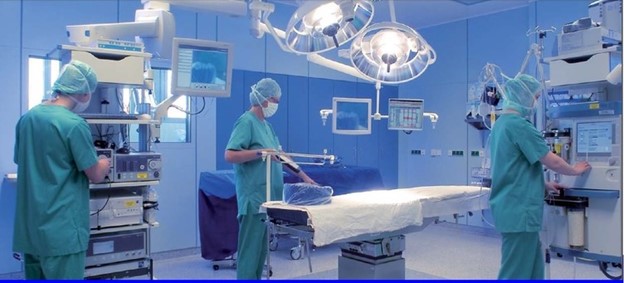Operation Room (OR) integration is the process of connecting medical equipment and systems to a single, unified platform. This technology has been around for some time, but it is becoming increasingly popular in the healthcare industry due to its many benefits. Connected OR integration systems allow for faster data sharing between different departments, better patient care, and improved efficiency.
By utilizing this technology, healthcare providers can optimize their operations and ensure that their patients receive the best possible care.
In today’s healthcare environment, it has become imperative to have a connected OR integration system in place. With the increasing number of connected devices, the need for seamless integration between these devices and systems also increases. This can be achieved by using an intelligent software platform that allows for automated data collection from various sources, such as patient records and lab results.
Due to the increasing demand for improved patient care and growing awareness of the benefits of integrated operating rooms, the US integrated OR market size is estimated to reach USD 3.6 billion by 2027, registering a CAGR of 10.1% during the forecast period (2020-2027).
Key Market Drivers: OR Integration
The growing adoption of minimally invasive surgeries and rising demand for advanced medical equipment are some of the major drivers contributing to the growth of the MedSurg market.
Increasing investments in healthcare infrastructure and favorable government policies are likely to provide lucrative opportunities for market players in the coming years. Additionally, increasing awareness about operational efficiency and cost savings associated with integrated operating rooms will further stimulate market growth.
The connected OR market trends include consumer adoption, increasing demand from healthcare providers, and modern technologies such as artificial intelligence (AI) and machine learning (ML).
These trends will enable hospitals to increase operational efficiency by automating processes such as auditing workflows or generating reports based on scheduled events that occur within the OR environment.
How Wireless Technologies Are Driving the Integration of OR Equipment?
In addition to these benefits, wireless technologies and cloud connectivity are also making it possible to implement remote monitoring and telemedicine in OR settings. With the use of wireless devices, healthcare providers can monitor patients’ vital signs and other important data in real-time, even when they are not physically present in the OR. This can be especially beneficial for patients who require constant monitoring or for situations where it may be difficult or unsafe for a healthcare provider to remain in the OR.
Moreover, remote monitoring and telemedicine can also enable healthcare providers to provide consultations or even perform procedures from a remote location. This can be particularly valuable in situations where a specialist may not be available on-site, or for patients who live in remote or underserved areas.
Overall, the integration of wireless technologies and cloud connectivity is transforming the way OR equipment is being used in healthcare settings. By enabling smoother communication and information transfer, these technologies are making it possible for healthcare providers to deliver more efficient and effective care to their patients. As these technologies evolve, they hold the potential to further revolutionize healthcare and improve patient outcomes.
How Connected OR Equipment Integration benefit All?
With the rise of connected devices, medical equipment manufacturers can create integrated solutions that streamline processes and create a more efficient workflow. This presents an opportunity for manufacturers to achieve a competitive advantage and improve their market share in the industry.
Moreover, manufacturers can use this trend to develop innovative products that would otherwise be difficult or impossible to create without integration. By leveraging existing technologies and platforms, manufacturers can quickly create products that can provide customers with more value.
OR integration is a powerful tool that can help to improve the productivity and efficiency of healthcare organizations while reducing costs. It can also provide improved patient security, better communication between staff members, and increased accuracy in data collection.
It can help healthcare organizations achieve their goals by automating processes and improving real-time data transfer. This helps to reduce errors, improve patient safety, and increase efficiency.
Additionally, OR integration can facilitate better communication between staff members by providing a central platform for sharing information. OR integration can reduce costs associated with manual hospital processes and other managerial tasks.
eInfochips’ medical devices engineering team has worked with one of the leading healthcare service providers to develop that is designed to help automate and streamline operating room processes by enabling bidirectional interaction between surgeons and nurses in real-time while leveraging mic arrays, stereo cameras, and speakers. As a result, the overall solution can take patient information, analyze data sets, track progress throughout surgeries, and provide real-time feedback by displaying it on an interactive screen.
Bottomline
The connected OR integration market is on the rise, and it presents a key opportunity for equipment manufacturers. Connected OR integration technology allows physicians and other hospital care staff to have real-time interaction with their patients, helping them provide the best possible care by streamlining their workflow and providing access to patient data.
However, integrating OR equipment into a healthcare facility requires careful planning and consideration before deployment. It involves connecting the equipment to a cloud platform, ensuring compatibility with existing systems and other equipment, and training staff on how to use it effectively. To ensure successful integration, several key steps should be taken before integrating OR equipment into a healthcare facility.
These include researching available options, evaluating the cost-benefit of each option, creating an implementation plan, and testing the system prior to going live. By taking these steps beforehand, manufacturers can ensure they have all the necessary pieces in place for a successful integration of OR equipment.














